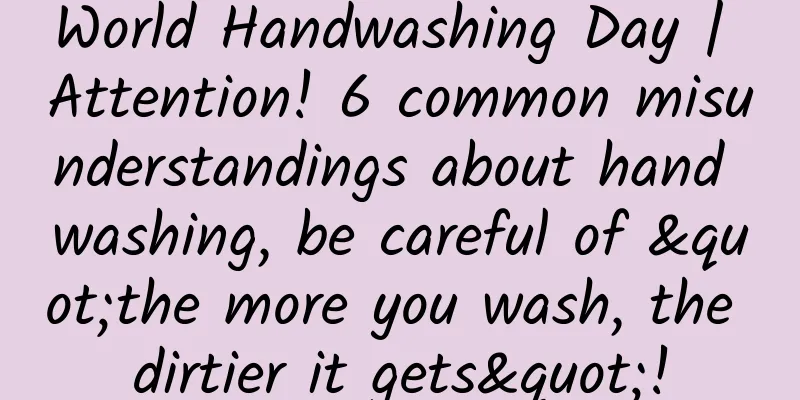World Handwashing Day | Attention! 6 common misunderstandings about hand washing, be careful of "the more you wash, the dirtier it gets"!

|
Today is World Handwashing Day . Some people may think, "Why do we need to be so particular about washing hands? Just put it under the tap and rinse it." Although we wash our hands every day, most people do not know how to wash them correctly and scientifically, and even "the more we wash, the dirtier our hands become." Are you really doing this ordinary little thing of washing hands correctly? Let's learn the correct way to wash hands. What should you pay attention to when washing your hands correctly? Wash your hands with running water , not basin water, and rub for at least 15 seconds . You cannot just wash your hands with water, you must use soap or hand sanitizer to effectively remove pathogens. In addition, the soap should be kept dry during use, and the soap box should be cleaned in time . If the bottom of the box is not kept dry, bacteria will breed in a humid environment. In addition, it should be noted that it is unhygienic for multiple people to share soap. Misconceptions about hand washing Myth 1: All hand sanitizers can kill bacteria Hand sanitizers are mainly divided into ordinary type and antibacterial type, so not all hand sanitizers have a bactericidal effect. Among antibacterial and bactericidal hand sanitizers, the antibacterial type has a bactericidal effect, but the bactericidal rate is relatively low. Generally, it can be labeled as antibacterial if it is greater than 90%, while the bactericidal hand sanitizer requires a bactericidal rate of 99.99% for the target bacteria . Myth 2: Using hand sanitizer instead of washing hands When using hand sanitizer, there will always be substances left on the surface of the hands, so try to use it as little as possible. It is best to wash your hands with running water and soap. In addition, many people use "easy" disinfectant wipes instead of washing their hands before dining. Experts point out that wet wipes cannot replace hand washing. No matter how many times you wipe your hands with wet wipes, they cannot remove bacteria on the surface of the skin . Myth 3: The more hand sanitizer you use, the better Many people are afraid that they can't wash their hands thoroughly, so they put a lot of hand sanitizer on their hands and rub them hard when washing. In fact, such deep cleaning will damage the skin, making it unable to retain moisture and more susceptible to bacteria . Myth 4: Washing hands in a wash basin Many people think that washing hands in a wash basin can also clean their hands. In fact, after repeated washing, the water in the wash basin has become dirty . Washing hands with dirty water will still make your hands dirty, and the purpose of washing hands cannot be achieved at all. There are even many people who wash their hands in the same basin of water, which makes the degree of hand pollution even more serious. Myth 5: Drying your hands with a towel after washing them After washing your hands, dry them naturally or wipe them with disposable paper towels. It is best not to use towels , as towels are prone to harbor germs and can easily contaminate washed hands. Don't use public towels. Myth 6: Not washing hands after hanging clothes Dirty clothes and bacteria in the washing machine will be transferred to the clothes during the washing process. In the process of hanging clothes, hands are likely to be stained with these bacteria . Clothes can eventually be disinfected by ultraviolet rays, but hands are often ignored. Seven steps to proper hand washing Step 1: Wash your palms. Wet your hands with running water, apply hand sanitizer (or soap), put your palms together, and rub your fingers together. Step 2: Wash the back of your fingers. Rub your palms against the back of your hands along the fingers, switching hands. Step 3: Wash the spaces between your fingers on the palm side. Place your palms together, cross your hands, and rub your fingers together. Step 4: Wash the back of your fingers. Bend the joints of your fingers, make a half fist, place the back of your fingers on the palm of your other hand, rotate and rub them, and repeat this process with both hands. Step 5: Wash your thumbs. Hold the thumb of one hand and rub it in a circular motion, switching hands. Step 6: Wash your fingertips. Bend the joints of your fingers, put your fingertips together in the palm of your other hand, rotate and rub them, and repeat this process with both hands. Step 7: Wash your wrists and arms. Rub your wrists and arms, alternating hands. When should you wash your hands? 1) Preparing food, touching raw meat, etc.; 2) Before meals, after bowel movements, and before taking medicines; 3) After touching the coins; 4) After contact with others, especially after (before) going to the hospital or contact with patients; 5) After cleaning, dispose of garbage; 6) After outdoor sports, homework, and shopping; 7) After playing outdoors and getting dirty; 8) After contact with blood, tears, mucus, sputum and saliva; 9) Before holding a child, especially if the child has come into contact with infectious items, the child's clothes must be disinfected and washed repeatedly; 10) After contact with pets. Produced by | Science Popularization China - Scientific Principles at a Glance |
<<: A picture shows the possible existence of "phosphorus of life" on Enceladus
Recommend
Hollywood has been spurned by American elites. Will the Chinese film market be good in the next two years?
In recent years, with the continued downturn in t...
Internet finance is not a "naughty child"
Ma Huateng once pointed out that for many traditi...
What are the characteristics and trends of advertising for tool apps?
Mobile tool apps are a type of app that started r...
The latest media operation tools in history (121 types)
The core essence of new media is actually tools ....
Sony PS-HX500 vinyl record player review: half music and half emotion
From a certain perspective, in addition to the hi...
Can silk be artificially produced?
Produced by: Science Popularization China Author:...
Six years of iOS development experience was replaced by interns, and the so-called "experience" is worthless
Written in front: Recently, I have seen many iOS ...
China Association of Automobile Manufacturers: From January to October 2021, the top ten car manufacturers sold a total of 5.018 million vehicles
According to statistics and analysis by the China...
How to control costs while improving conversion effects through advertising?
For those who are new to the industry, it may be ...
What are the benefits of the 2022 infant and child care personal income tax? How to apply specifically? Attach details
Starting from 2022, one more special deduction it...
How can traffic be doubled relying solely on content? It's time to think about your KPIs!
The golden age of short videos Why do we say that...
What did a 5,000-year-old jade mask look like?
"This jade mask is a kind of funeral jade. T...
When ancient history meets cutting-edge technology: Helping to decipher Greek inscriptions and achieving a dance between AI and humanity?
*Inscriptions and steles are the embodiment of th...









